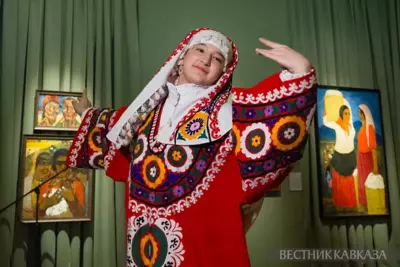It is important to know Karabakh's history to understand the reasons behind current geopolitical developments in the South Caucasus, Fazil Gasimov, a PhD student in Istanbul University, UNESCO Representative of UNESCO-accredited "Ashiq Shamshir" Cultural Center Public Union writes in the article OPINION - Gregorian Church bears responsibility for disappearance of Karabakh's Christian Albanians for Anadolu Agency. He shares the results of his research on Karabakh's history from different sources.
Aziz Alakbarli, Ph.D. in Philology, writes in his book "Armenian Surnames of Turkish Origin": "The rulers of Karakoyunlu, Akkoyunlu and Safavid put a special emphasis on Christianity for political purposes. In their struggle against each other, the Muslim Jahangirs (sultans) tried to find allies among the Christian countries and also to benefit from their Christian population in this process. To this end, in 1441, the ruler of Karakoyunlu, Jihanshah, allowed the Armenian Apostolic Catholicosate to move from Sis city of Cilicia (Kozan district of Adana, Turkey) to a Christian temple near Yerevan."
After the Gregorian Church moved from Cilicia to Echmiadzin (historical Uchkilse), which is 20 km south of Yerevan, there was increasing pressure on Caucasian Albanian churches in Western Azerbaijan and Karabakh. Eventually, Albanian Catholicos residing in Ganjasar Monastery (Kelbajar province of Azerbaijan) fell under the influence of the Gregorian Church. After Tsarist Russia occupied the Karabakh Khanate, Alban (Agvan) Catholicosate was abolished with the decree of Nicholas I dated on March 11, 1836, due to the insistence of the heads of the Gregorian Church.
As a result, the Caucasian Albanian Apostolic Church was taken under the control of the Echmiadzin Gregorian Church. As of this date, the Gregorian Church started appointing Armenian priests to work in Caucasian Albanian churches in Azerbaijan, and thus the process of appropriation and Armenianization of Albanian churches by the Gregorian Church started.
Tsarist Russia found the Gregorian Church as a reliable ally in implementing colonial policies in the South Caucasus. The regime used the Armenians and Gregorian Church to pursue geopolitical interests in the region. For this purpose, with the Treaty of Turkmenchay signed between Qajar Iran and Russia in 1828, and the Treaty of Edirne signed between the Ottoman and Russia in 1829, tens of thousands of Armenian families were moved from Iran and from Eastern Anatolia to Karabakh and Western Azerbaijan.
For example, in his article titled "A New Threat to Russian Policies in the South Caucasus", Nikolay Shavrov writes: "Within two years after the end of the 1826-1828 war, 40 thousand Iranian Armenians and 84 thousand Ottoman Armenians were sent to the South Caucasus from 1828 to 1830. We settled them in the most fertile state lands of Ganja and Yerevan provinces, where the Armenian population is less.
We also placed them in the Borchali, Akhiska and Akhalkalaki districts of Tbilisi province. For their settlement, more than 200,000 dessiatin of state-owned land were allocated and private property land worth more than 2 million rubles was purchased from Muslims. These Armenians were settled in the mountainous part of Yelizavetpol province (Nagorno-Karabakh) and on Lake Goyce. Besides 124 thousand Armenians who were officially settled, in general, the number of Armenian migrants was more than 200 thousand if we consider hundreds of unofficial migrants."
Referring to the report on the census carried out under the leadership of Ivan Chopin in 1829, Armenian historian and professor at the University of California, George Bournoutian summarized the demographic change as follows: "In 1826, the Armenian population in Yerevan and Nakhichevan khanates increased from 25,151 to 82,377, and the Muslim population decreased from 117,849 to 82,073 in the same period. After the Russian-Turkish wars of 1855-1856 and 1877-1878, more Armenians were settled in the South Caucasus. "
Armenians who were settled in Nagorno-Karabakh were mainly located in Khankendi, Khojavend and Agdere regions of Azerbaijan. Khankendi town, where 55 thousand Armenians live today, was built at the end of the 18th century as a resting place for Karabakh khans. While it was a village inhabited by Azerbaijani Turks in the beginning of the 19th century, with the agreements of Turkmenchay and Edirne, Khankendi turned into an Armenian settlement, after the migration of Armenians from Iran and Eastern Anatolia. In 1923, the city's name was changed to Stepanakert after Stepan Shaumian, who was a Bolshevik revolutionary and politician, and Khankendi was declared the center of the Nagorno-Karabakh Autonomous Region.
Thus, as a result of Armenians' settlement in Western Azerbaijan and Karabakh in the 19-20th centuries and the massacres and forced migration against Azerbaijanis in these regions, the demographic situation significantly changed in favor of the Armenians. The geographical names of Turkic origin in the region were also replaced with Armenian toponyms.
During the reign of the Safavid ruler Shah Ismail, Karabakh was subordinate to the Ganja-Karabakh province. During the Safavid-Ottoman wars (1514-1555, 1578-1590, etc.) Karabakh passed from hand to hand. In 1588-1605 and 1725-1735, Karabakh was a part of the Ottoman Empire. After the Treaty of Istanbul signed between the Safavid State and the Ottoman Empire in 1590, the "Mufassal Book of the Ganja-Karabakh province" was prepared due to the census in Karabakh. According to the Mufassal Book, 61% of the population in the province of Ganja-Karabakh was Muslim and the rest was non-Muslim.
The non-Muslim population was usually tribes of the Caucasian Albania of Christian faith. In the 18th century, the Muslim population of Otuziki, Javanshir and Kebirli regions of Karabakh was taken to Afghanistan to gain local support in Nadir Shah's eastward march. Their descendants now live in Afghanistan in the cities of Kabul, Herat, Logar and Kandahar.
In the 17th century, during the Safavid period, melikdoms were established in regions with Christian populations in the historical Albanian lands and the administration of these melikdoms was entrusted to the Christian feudal lords. Meliks were dependent on Ganja-Karabakh governors during the Safavid period and Karabakh khan in the following period. During the reign of Nadir Shah Afshar (1736-1747), the Karabagh meliks were semi-independent for a while, but under the pressure of the Panahali khan of Karabakh Khanate, they became again utterly dependent. Karabakh's Christian population resided in the lands of five Albanian melikdoms (Khachin, Gulustan, Chilebord, Varanda, Dizak).
Except for the Meliks of the Khachin, the meliks were not originally from Karabakh and came to this land from other places. The 19th century - Persian Armenian historian Raffi and Azerbaijani historian Mirza Adigozel Bey Karabaghi stated that Melik Usub of Gulustan (Talysh) moved from Shirvan (Gabala-Nij village), Melik Shahnazar of Varanda from Goyce, Melik Yegan of Dizak from Lori, Melik Allahkulu of Chilebord from Zangezur to Karabakh. The population of the Melik of the Khachin was descended from Albanian tribes living in Karabagh since ancient times.
The Albanian Catholicos at the Ganjasar Monastery were descendants of the meliks of the Khachin. The meliks of the Khachin were the successors of the Principality of Khachin (1261-1603), which was founded by Hasan Jalal Dawla. Therefore, it was known as the most influential melikdom. There were many Albanian temples in the territory of the Melikdom of the Khachin, including well-known Khudaveng and Ganjasar Alban monasteries. Ganjasar Monastery hosted the Albanian Catholicosate as the center of the Albanian Apostolic Church in 1240-1836.
Karabakh meliks affected by the Ottoman-Safavid wars complained of Muslim rulers to the Russian tsars in the letters in the 18th century and asked them to protect the Christians living in Karabakh. For example, in 1701, Melik Abov II of Gulustan wrote a letter to the Russian Tsar Peter I. In his letter, he introduced himself as "Udi of Albania".
In March 1723, in another letter written by the four meliks of Karabakh - Essai, Shirvan, Sergei and Jozef to Peter I, the meliks introduced themselves as "Christian Agvans (Albanians)" and the people they represented as "nation of Agvan". Although these letters are preserved in Armenian and Russian archives and published by Armenian writers, Armenian historians continue to distort historical facts by presenting the Karabakh meliks as Armenian feudal heads of state. Simultaneously, the conflicts between the Karabakh meliks and the Muslim rulers are dramatized and taught in Armenian schools for anti-Turkish propaganda purposes as an example of Armenian-Turkish hostility.
In the 18th century, power struggles took place between the Karabakh meliks and the Karabakh khans. After the defeat of Melik Ulubab of Khachin in Balligaya, the latest recognized the rule of Panahali khan of Karabakh.
Panahali khan also became a relative of Melik Shahnazar of Varanda, as his son Ibrahim Khalil Khan married Hurizad, daughter of Melik Shahnazar, who, as a result, recognized his rule. However, the Dizak, Chilebord and Gulustan meliks resisted the rule of Panahali khan for several years. Nevertheless, Ibrahim Khalil Khan continued the success of his father in making the meliks dependent. The Melik Shahnazar of Varanda and the Melik Mirzakhan of Khachin recognized Ibrahim Khalil Khan's rule and joined the union he created. However, Melik Essai of Dizak, Melik Mejnun of Chilebord and Melik Baylaryan of Gulustan refused to recognize Ibrahim Khalil khan’s rule. From 1783, Tsarist Russia began to intervene in the conflict between Ibrahim Khalil khan and meliks.
Trying to occupy the South Caucasus, Russia tried to gain support in Azerbaijani lands with the help of the Karabakh meliks. At that time, thanks to his diplomatic skills, Ibrahim Khalil khan gathered the resisting meliks in Shusha. He proved that these meliks had indeed betrayed the Karabakh Khanate and ordered their imprisonment. Then, Melik Mejnun of Chilebord and Melik Abov III of Gulustan were taken to prison in Shusha and the Melik Bahtam of Dizak was handed over to Ardabil khan for his crimes.
As I have mentioned above, in the begining of the 19th century, the Southern Caucasus came under the control of Tsarist Russia, mass migration of Armenians from Iran and Eastern Anatolia to Karabakh began and Albanian churches were subordinated to the Gregorian Church. In this context, the Christian Albanian population of Karabakh faced two options:
1) Converting to Islam and transforming into the Turkish population of the Karabakh region, or
2) To accept the Gregorian Christian sect and to carry the Armenian national identity (gregorianization)
In this case, the families of Albanian meliks in Karabakh had to choose one of the above two options. Some of the Karabakh Armenians are descendants of Albanian feudal meliks who converted to the Gregorian sect in the 19th century. Although they have gained Armenian national identity, they are Christian Albanians who were assimilated by the Gregorian Church. Among the descendants of Albanian feudal meliks who converted to Islam, there are prominent figures and well-known families of Azerbaijan. Many of them became Internally Displaced People at the beginning of the 1990s. Few of them left Karabakh long before the First Karabakh War and settled in other parts of Azerbaijan.
Tugh Village of Khojavend was the center of the Dizak district during the Safavid state and Karabakh Khanate. Melik Yegan's family of Dizak had settled in this village. The Russian Tsar Petro I gave Melik Yegan of Dizak the rank of General. After the death of Melik Essai - the son of Melik Yegan, the Yegan family had to either become Gregorian according to their religious beliefs or become part of the surrounding Turks and converts to Islam. Eventually, a large part of Yegan's family converted to Islam. Two well-known representatives of the Yegan family, Javad Bey Melik-Yeganov and Hudadat Bey Melik-Aslanov, took part in establishing the Azerbaijan Democratic Republic.
Javad Bey Melik-Yeganov, as a member of the Azerbaijan National Council, signed the Declaration of Independence of Azerbaijan on May 28, 1918, and became one of the founders of the Azerbaijan Republic. Javad Bey served as the governor of Lankaran during the Azerbaijan Democratic Republic. Like many Azerbaijani intellectuals in the 1930s, he was declared an "enemy of the people" by Soviet Administration and exiled to Medvejyegorsk, a town bordering Finland.
Another Azerbaijani of Albanian origin from Tugh village was Professor Hudadat Bey Melik-Aslanov, who worked as the first Minister of Transport, Postal Service and Telegraph of the Azerbaijan Democratic Republic. He was treated similarly by Soviet Administration and was exiled to Siberia in the 1930s. Hudadat Bey's grandson, Professor Ramiz Melikaslanov, a national artist, manages one of Turkey's most famous orchestras. Ramiz Melikaslanov was awarded the "Anniversary Medal" by the President of Azerbaijan on the 100th anniversary of the Azerbaijan Democratic Republic in 2019.
Sadikh Bey and Mehdi Bey Melikaslanovs, descendants of Melik Yegan of Dizak, founded the Russian-European style Tugh school in Karabakh in 1883, which accelerated the Enlightenment movement in Azerbaijan. In a declaration signed by Russian Emperor Alexander II in 1883, it was stated that the religious school (mullah), which had been operating since 1850 in Tugh village of Shusha district of Yelizavetpol province, was given the status of a Russian-European school.
Uzeyir Bey Hajibeyov, the famous composer of Azerbaijan, taught at Tugh School. Hudadat Bey Melikaslanov and Javad Bey Melikyeganov were graduates of this school. Author of the book "History of Karabakh", historian and poet Mir Mehdi Hazani was the director of Tugh School for a while. In 1991, Armenian troops occupied Tugh village, which was finally got liberated on October 9, 2020, by the Azerbaijani Army during the Second Karabakh War.
It is also significant to mention that some members of the Yegan family (i.e., the chief therapist of Armenia, professor of medical sciences Gagik Azatovich Yeganyan, professor of economics Mikael Nikolayevich Yeganyan, Armenian statesman, economist Gagik Kimovich Yeganyan) converted to Gregorian faith and eventually got Armenianized.
In a nutshell, the assimilation of the Caucasian Albanians in Karabakh was completed by the Gregorian Church in the middle of the 19th century. However, the Gregorian Church's purpose was to Armenianize all Christian Albanians living in Azerbaijan and fully dominate the heritage of the Christian Albanians. In reaction to the subordination of Albanian churches by Armenian priests, most of the Alban-Udis living in Sheki, Gabala and Oghuz provinces of Azerbaijan refused to go to church and preferred to worship in their homes, thus, were able to preserve their national identity and religious beliefs until now.
In 2003, the State Committee for Working with Religious Institutions in Azerbaijan registered the Alban-Udi Christian Community and the Kish Albanian Church located in the Sheki region which is one of the oldest churches in the Caucasus was restored. In 2006, Jotari Church, named after the Holy Elysee, one of the three Christian Albanian Churches in Nij village in the Gabala region, was restored and opened its doors to the Alban-Udi people.
In 2020, the Maryam Ana Alban Church in Nij village was restored by the Haydar Aliyev Foundation and opened for worship with the President of Azerbaijan's participation. Although Albanian churches in Karabakh (Ganjasar, Khudaveng, Amaras, Holy Elysee, Agoghlan, Urekveng, Gtichavank, etc.) have similar architecture and characteristics to Kish, Jotari and Maryam Ana Churchs in all respects, both the Gregorian Church and the Armenian historians and politicians presented those churches as Armenian churches and showed them as evidence for the false claims that Karabakh was an ancient settlement of Armenians.
Both Gregorian Church and Armenian politicians and historians appropriated the Albanian churches and attempted to Armenianize the Albanian rulers, historians, and canons. In 2009, the "Vachagan Barepasht Medal" was established by the administration of the so-called "Nagorno-Karabakh Republic" in the name of the Albanian ruler Vachagan III. Then, businessmen who invested in the Nagorno-Karabakh region since the early 1990s, politicians and artists who supported the so-called "Nagorno-Karabakh Republic" were awarded the Vachagan Barepasht Medal.
In a report published in Russia's pro-Armenian REGNUM News Agency in 2011, it was announced that with the decision of the administration of the so-called "Nagorno-Karabakh Republic", the monument will be built in Shusha in honor of Vachagan III. REGNUM correspondent introduced the rule of Albanian king Vachagan III as an example of Armenian statehood. In an article published on Radio Free Europe in 2009, the representative of the so-called "Nagorno-Karabakh Republic" to the USA presented false information regarding the Albanian canons by claiming that the Aguen (Agvan) canons of the Aguen Church Council held in Agdam region of Karabakh by the instructions of the Albanian ruler Vachagan III, are the oldest known Armenian Constitution.
The Gregorian Church and Armenian historians also appropriated the Holy Elysee Monastery located in Agdere region of Nagorno-Karabakh. Meanwhile, Albanian ruler Vachagan III was buried in the Holy Elysee Monastery. Albanian historian Movses Kaghankatvatsi, who wrote "History of the Country of Albania" at the request of Albanian ruler Javanshir, Mkhitar Gosh who is the author of "Albanian Chronicles", Albanian Catholicos Essai Hasan Jalal who is the author of "A Brief History of the Albanian Country" were also Armenianized by Armenian historians.
With the pressures of Armenian priests working in Albanian Churches that came under the control of the Gregorian Church in 1836, some of the Alban-Udis living in the northern provinces of Azerbaijan became Gregorian during the Soviet period as the Christian community of Karabakh did in the early 19th century.
Alban-Udis, who became Gregorian in the Oghuz and Gabala provinces of Azerbaijan, moved to Armenia and Russia after the collapse of the Soviet Union. Alban-Udis, who lived in Armenia, founded an NGO called "The Renaissance of the Udi People of Historical Albania" in 2018 and asked the Armenian government to recognize the Udis as a minority.
Alban-Udis, who predominantly lives in Bagratashen on the Georgian border in the Tavush region of Armenia, held their first event in 2018. The establishment of contacts between the Alban-Udi Christian Community of Azerbaijan and the Armenian NGO "The Renaissance of the Udi People of Historical Albania" would reveal the historical facts regarding the Albanian religious heritage and national identity in the South Caucasus.
As a final note, I would like to share the position of the Azerbaijani government on this issue. In his speech to the nation on November 25, 2020, Azerbaijani President Ilham Aliyev criticized the attempts of Armenians to Armenianize the Albanian religious heritage in the Nagorno-Karabakh region:
"The historical monuments of Kalbajar are our great heritage. Both mosques and churches are our historical heritage. The Azerbaijani people know this very well and the whole world should know that the churches in Kalbajar belong to the historical Caucasian Albanian state. Many historical documents are confirming this.
It is no secret that Armenian historians and fraudsters Armenianized Albanian churches added their own texts and attributed these churches to themselves. It is enough to look at history. Then, in the 1830s, Tsarist Russia abolished the Albanian (Apostolic) Church, gave all the properties of the Albanian Church to the Armenian Gregorian Church, and the Armenian priests and their patrons started to claim ownership of these churches. Their main task was to erase the history of Caucasian Albania and make it forget. But we did not allow that. Azerbaijan has a wide scientific basis and works on this subject.
These studies should be introduced not only to the scientific community but to the world as a whole. Caucasian Albania was a big state. Its capital was Gabala. Historical monuments and churches belonging to Caucasian Albania are our historical and cultural heritage. We protect these churches. I have visited these churches many times in the Sheki and Gabala area.
As you know, with the initiative of the Haydar Aliyev Foundation, the restoration work of the historical Udi Church of Caucasian Albania in Nij village was completed and this church was opened during the war. We preserve these churches as our cultural heritage. Therefore, nobody should worry. These churches will continue to be protected by the state. The world community and world leaders appreciate Azerbaijan's policy on multiculturalism and interfaith relations."






